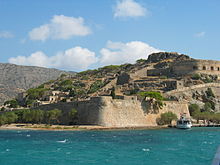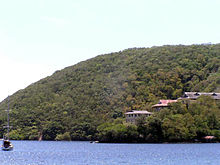Why don't we learn from the wisdom of the Middle Ages and set up colonies for all the unvaxxed.
https://en.wikipedia.org/wiki/Leper_colony
Leper colony
From Wikipedia, the free encyclopedia
For the EP by Fallujah, see
Leper Colony (EP).
 Spinalonga
Spinalonga on
Crete,
Greece, one of the last leprosy colonies in
Europe, closed in 1957.
A
leper colony,
lazarette,
leprosarium, or
lazar house was historically a place to
isolate people with
leprosy (Hansen's disease). The term
lazaretto, which is derived from the name of the biblical figure
Saint Lazarus, can refer to
isolation sites, which were at some time also "colonies", or places where lepers lived or were sent.
[1] Many of the first lazarettes were operated by Christian monastic houses.
[2] Leper hospitals exist throughout the world to treat those afflicted with leprosy, especially in Africa, Brazil, China and India.
[2]
Contents
History

Abandoned nun's quarters at the leper colony on
Chacachacare Island in
Trinidad and Tobago
Leper colonies or houses became widespread in the
Middle Ages, particularly in Europe and India, and were often run by monastic orders. Historically,
leprosy has been greatly feared because it causes visible disfigurement and disability, was incurable, and was commonly believed to be highly contagious. A leper colony administered by a Roman Catholic order was often called a lazar house, after
Lazarus, the patron saint of people affected with leprosy.
[3]
Some colonies were located on mountains or in remote locations in order to ensure isolation, some on main roads, where donations would be made for their upkeep. Debate exists over the conditions found within historical colonies; while they are currently thought to have been grim and neglected places, there are some indications that life within a leper colony or house was no worse than the life of other, non-isolated individuals. There is even doubt that the current definition of leprosy can be retrospectively applied to the Medieval condition. What was classified as leprosy then covers a wide range of skin conditions that would be classified as distinct afflictions today.
[4]
Some leper colonies
issued their own money (such as tokens), in the belief that allowing people affected by leprosy to handle regular money could spread the disease.
[5][6]
In 1623 the
Congregation of the Mission, a
Catholic society of apostolic life founded by
Vincent de Paul, was given possession of the Priory of St. Lazarus (formerly a lazar house) in Paris, due to which the entire Congregation gained the name of
Lazarites or
Lazarists—though most of its members had nothing to do with caring for lepers.
Political aspects

Laoe Si Momo (Spring Water) leper colony was founded on August 25, 1906 in the
Batak region of
Sumatra, 10 kilometers from Kaban Jahe. Within five months it was home to 72 people affected with leprosy and by April 1921 colony included 280. The patients lived in small houses.
In 2001, government-run
leper colonies in Japan came under judicial scrutiny, leading to the determination that the Japanese government had mistreated the patients, and the district court ordered Japan to pay
compensation to former patients.
[7] In 2002, a formal inquiry into these colonies was set up, and in March 2005, the policy was strongly denounced. "Japan's policy of absolute quarantine... did not have any scientific grounds."
[8] The inquiry denounced not only the government and the doctors who were involved with the policy, but also the court that repeatedly ruled in favor of the government when the policy was challenged, as well as the media, which failed to report the plight of the victims.
See also